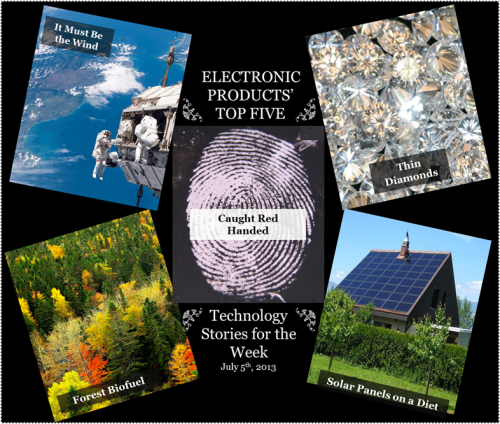In case you didn’t catch all of the top technology stories this week, take a look at what you missed! Solar panels weighing less than a tissue, new forensic technology to crack down on criminals, and a safety precaution for the International Space Station are just a handful of the innovations taking over the world this week. Check ‘em out!

It Must Be the Wind
New Technology to Hear if Air Leaks From the International Space Station
Currently, there is a system aboard the International Space Station (ISS) with alarms that sound if air starts leaking into the pressurized units. In this case, the astronauts have to figure out where exactly the leak is coming from. NASA is working on implementing a new technology that uses DIDS units (digitizers with the capability to record ultrasonic noises), that will be able to detect where air is seeping through the metal directly. Eric Madaras and his team are working on a system that will eventually minimize possible disastrous damage aboard the ISS.
Caught Red Handed
Forensics and Technology Crack Down on Criminals
Today, only 10% of found fingerprints are sufficient to serve as evidence in a court case. Researchers at the University of Leicester have discovered a method to discover fingerprints using electrodispostion of polypyrrole, making it possible to detect fingerprints after a criminal’s attempt to wipe them away. In this method, the fingerprint acts as a stencil that avoids electric current, directing a colored powder to create a negative replication of the fingerprint, which then changes to different colors when exposed to light. This is expected to change the face of forensic fingerprinting in criminal cases.
Thin Diamonds
Thin Diamond Coating Assists Electronics
Who would have thought diamonds found on a ring or necklace would ever help electronics? Researchers at Advanced Diamond Technologies, Inc. invented a boron-doped thin diamond coating, causing the diamonds to stray away from their usual hard, smooth, and clear stereotype and move toward a conductive film. The team lowered the temperature to 400°F when creating the coating to allow the change in smoothness and conductivity to occur. This method is still a work in progress, as the team is now experimenting with different temperatures. Eventually this discovery is expected to expand the uses of electronic devices.
Solar Panels on a Diet
Thinner Solar Panel Discovery Means More Power
A team of researchers at MIT is currently working on improving solar panels by creating the thinnest and lightest solar panel yet. Atom-thin photovoltaic sheets weighing less than a tissue could increase the overall efficiency. Marco Bernardi, leader of the project, believes that this innovation will help in situations where extra weight is a problem, such as on space shuttles, aircraft, and in remote places where transportation costs can be reduced. Bernardi claims that his thinner solar panel produces 1,000 times more power than the conventional solar panels while weighing 20 to 50 pounds less.
Forest Biofuel
A New Way of Recycling Forest Residue
We’re always trying to find the least-expensive and most innovative way of saving the forest while still benefiting society. The best way to do this is to create biofuel out of forest residue in an inexpensive and efficient way. Researchers at the VTT Technical Research Centre of Finland have developed a new technology taking forest residue, like fallen tree bark, and using gasification to renew energy. The production of biomethanol proved to be the most successful and is currently in the planning stage for public use in Finland and the European Union. Methanol can be used for synthetic gasoline and renewable raw material.
Advertisement
Learn more about Electronic Products Magazine





